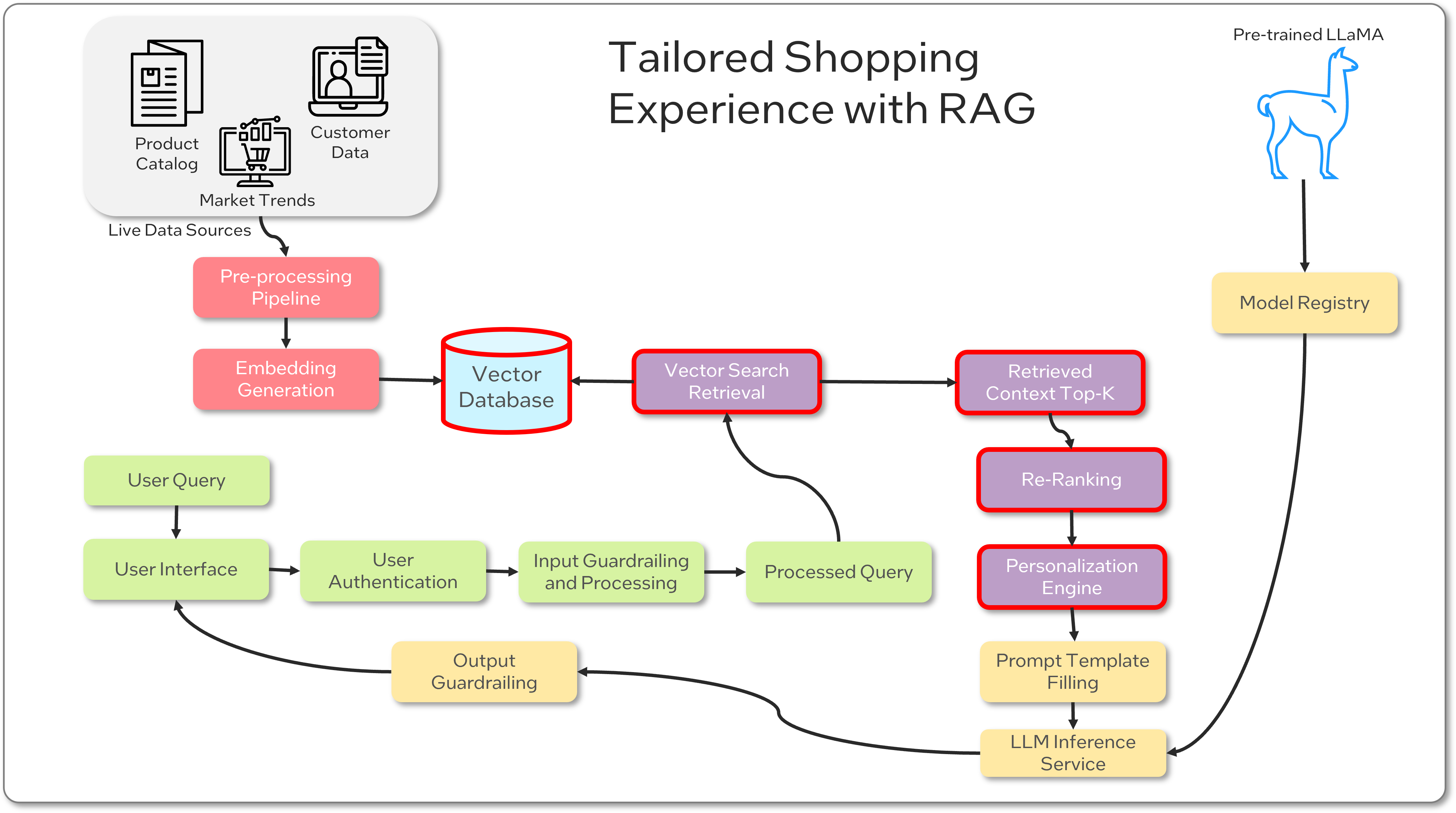This article was originally published on Medium*.
Deliver dynamic, fresh, and timely recommendations to shoppers with RAG.
In today’s fast-paced retail environment, traditional recommendation systems face challenges in keeping up with rapidly changing consumer preferences. These systems, which frequently rely on static data and static algorithms, can struggle to adapt to the variability of customer desires and market trends. This shortcoming can lead to a suboptimal shopping experience and a negative impact on retailers' financial performance through missed sales and reduced customer loyalty.
A cutting-edge solution to this challenge is the RAG-based recommendation system. By taking advantage of advanced retrieval techniques, RAG provides up-to-the-minute recommendations tailored to individual customers' preferences, ensuring that suggestions are as current as the latest X (formerly Twitter*) trend and as personal as a handwritten note.

Figure 1. RAG-based recommendation system architecture
Live data sources pass through a preprocessing pipeline and embedding model, with the output stored in a vector database. User queries are processed, and the retrieved context from the vector database is reranked and personalized with prompt filling incorporating the retrieved context. The final output is guardrailed and postprocessed.
The previous diagram illustrates the high-level architectural elements of a RAG-based retail recommendation system. In this article, we will take a closer look at its various components and flow.
The Challenge of Personalization in Retail
Traditional recommendation engines have long been a staple in e-commerce and brick-and-mortar retail, guiding customers toward their next purchase. However, the engines' inability to quickly adapt to real-time data and consider nuanced customer feedback has decreased the relevance of the engines' suggestions. This lack of relevance is a missed opportunity in an industry where personalization is highly valued.
Introducing RAG for Retail
The RAG-based recommendation system redefines personalization by dynamically integrating vast amounts of data, from market trends to individual customer interactions, into the recommendation process. This ensures that product suggestions are relevant and timely, enhancing the shopping experience and fostering stronger customer relationships.
For example, when Emma, a shopper, searches for a dress for an upcoming wedding, the RAG-based system generates an embedding from her query and interacts with the vector database to find the best matches. It then reranks the top search results based on Emma’s previous purchases and browsing behavior and adapts the suggestions further by considering Emma’s color preferences and past feedback on dress sizes for specific brands.
Emma is presented with a curated selection of dresses that are trend-aligned and tailored to her personal style and preferences. As she interacts with the system, the RAG-based recommendation system learns from her behavior, improving the accuracy of future recommendations. Overall, the RAG-based recommendation system provides a personalized shopping experience that is up-to-date with the latest market trends.
How RAG Works in Retail
The RAG system unfolds across three primary layers, each playing a pivotal role in delivering personalized product suggestions (figure 2).

Figure 2. Various layers of our proposed RAG retail application
Data Collection and Integration Layer
This foundational layer aggregates data from diverse sources, including e-commerce platforms, customer relationship management (CRM) systems, and social media. It ensures a holistic view of customer preferences and market trends, feeding into a centralized data lake alongside a constantly updated product catalog (figure 3).

Figure 3. Highlighting the data collection and integration Layer of the solution architecture.
The RAG Layer
At the heart of the system lies the RAG layer. This layer retrieves pertinent information from a vector database, which houses a rich collection of customer preferences, market trends, and product details. It's here that the system ensures recommendations are relevant to the current market and personalized to the individual (figure 4).

Figure 4. Highlighting the RAG layer of the solution architecture
Recommendation Generation and Personalization
Armed with insights from the RAG layer, the system dynamically generates personalized product suggestions. These recommendations are fine-tuned based on the customer’s historical data and preferences, ensuring a tailored shopping experience (figure 5).

Figure 5. Highlighting the recommendation generation and personalization of the solution architecture
Benefits of RAG in Retail
The implementation of a RAG-based recommendation system heralds numerous benefits for retailers. Most notably, it drives sales and fosters customer loyalty through improved satisfaction. By delivering timely and relevant product suggestions, retailers can ensure their offerings resonate with customers, encouraging repeat visits and purchases (figure 6).

Figure 6. Highlighting the key benefits of RAG in retail
Summary
As the retail industry evolves, technologies like RAG are becoming increasingly important for retailers who want to stay competitive.
RAG has the potential to transform retail by providing real-time, personalized recommendations that are tailored to individual customer's preferences, market trends, product inventories, and more. By taking advantage of these solutions and techniques, retailers can provide a more engaging and personalized shopping experience, which can lead to increased customer loyalty and revenue.
Next Steps
Register for free on the Intel® Tiber™ Developer Cloud, and then implement the RAG with LangChain code sample on Intel Tiber Developer Cloud using datasets ranging from robot maintenance to grocery store cashiers.
Also, you can access various code sample demos available in machine learning and generative AI domains. After signing in, to launch a free Jupyter environment, select Training and then Launch Jupyter. Try out these demos and run them on the latest Intel hardware such as Intel® Xeon® processors and Intel® Gaudi® accelerators.
We encourage you to also check out and incorporate Intel’s other AI and machine learning framework optimizations and end-to-end portfolio of tools into your AI workflow and learn about the unified, open, standards-based oneAPI programming model that forms the foundation of Intel® AI Software Portfolio to help you prepare, build, deploy, and scale your AI solutions.
AI Tools
Accelerate data science and AI pipelines—from preprocessing through machine learning—and provide interoperability for efficient model development.
You May Also Like
Related Articles